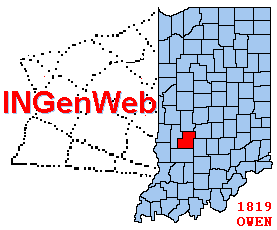Early Settlers
Source: History of Owen County, James Archer, 1884
The territory of which Owen County is a part originally belonged to the Miami, Pottawatomie, Delaware, and Eel River tribes of Indians, and was ceded to the whites by the chiefs of these tribes by the treaty of Fort Wayne September 30, 1809. Owen County was settled first by the whites in 1816, and for a number of years subsequent to that time large numbers of Indians gained their subsistence by hunting and fishing in the bounds of what is now Owen County. When the first white settlers came to this county the forests abounded with game of all kinds and the streams were full of the finest fish, a veritable paradise for the hunter. With very little trouble the early settler could supply the inmates of his cabin with an abundance of the finest bear meat, venison, and wild turkey, and with his "gig" or fish spear, as true to his aim in water as his unerring rifle on land, he could quickly take all the fish he wanted, taking choice as to size and kind.
The extensive rich alluvial "bottoms" of White River were covered with a dense luxuriant growth of wild pea-vine, which afforded unlimited range for game of all kinds. Wild turkeys and deer were frequently shot by the early settlers while standing in their cabin doors. The first white settlers in what is now Owen County was Philip Hart, who settled where Calvin Fletcher, Esq. now lives, adjoining Spencer on the northeast. Philip Hart came here in October, 1816. He brought with him his family, consisting of his wife Susan and seven children. An unmarried man, James Bigger, came with Hart and afterward married one of the Hart girls. In the fall of 1816, John Dunn, Gen. Bartholomew, the Beems and some others bought land in this county at the land sales at the old Post Vincennes. On the 5th day of February, 1817, John Dunn came here with his family consisting of his wife Margaret, or "Peggy," as she was called, and six children. He crossed the river with teams and stock on the ice at "Mayfield's Eddy" and camped on the snow at the spring at the foot of the "narrows" above Spencer. Samuel W., his son, was then thirteen years of age, and is yet living. Margaret, his daughter, my mother, who is yet living, was then six years of age. Samuel and his father at once commenced cutting logs for a cabin; assisted by Philip Hart and James Bigger, they got up the walls and a roof of clapboards on in a few days. They scraped the snow out of the cabin, built a fire-place and chimney of "cat and clay," built a big fire and moved in on the dirt floor, with neither door, nor window shutter, and often in after days, when they lived in a fine residence surrounded by all the comforts of life in plenty, I have heard Grandmother Dunn say that she never felt so rich and happy in her life, either before or after as when she moved into that cabin and had her little children under its shelter. Grandfather bored holes in the logs at the proper distance from the ground, secured the ends of round poles in the auger holes, the others on forks driven in the ground, then placed boards, split of oak, across the poles, and the beds were then placed on top of the boards. Sweet and refreshing sleep visited them thus in such rude surroundings. John Dunn lived on the river bank, and soon made a large canoe, which was used for ferriage purposes. The men were busy clearing ground of the timber preparing for a crop, and the women attended the ferry. My mother became an expert with the canoe paddle, and ferried many persons across White River ere she had reached her "teens." She retained her knowledge of the use of the paddle for many years as I can testify. I was her first born child, a very mischievous boy, tradition says, and I often hunted for a soft easy place to sit down upon by reason of that same "proficiency with the paddle," which my mother had retained, and with which, no canoe being handy, on particularly mischievous provocations she "paddled" me.
Gen. Bartholomew bought the land where Benjamin E. Allison and Henry Keene now live. Richard Beem bought the land upon which the most of what is now the town of Spencer is located. John Bartholomew came and brought his family in April, 1817. He built his cabin on the south side of the hill upon which Henry Keene now lives. Thomas, John and Robert McNaught came then also. Thomas bought and settled upon the land which his son, Gen. Thomas A. McNaught now owns and lives upon. On the 25th of March, Neely, Enoch, and Levi Beem, sons of Daniel Beem, came and made their camp upon a mound south of Spencer, which mound is now in the Riverside Cemetery. Neely Beem brought his wife and infant daughter, two weeks old, along with him. That infant grew to womanhood, and became the mother of Laura A., wife of Gen. T. A. McNaught. Enoch Beem was about seventeen, and Levi about fourteen years when they arrived here. Their father, Daniel Beem, was sick, and was left at the old home in Jackson County, Ind. These boys lived in their camp until they had cleared and planted ten acres in corn. They then built their cabin on the mound above mentioned. In the spring of 1817, there came to this Dunn settlement, as it was called, Isaiah Cooper, Jacob McIntire, Dudley Milner, Richard Kirby, William Anderson, Robert Blaine, George McHenry, and Hugh Barnes, with their wives and children. These men all made crops here in 1817. They had to clear their lands from the green timber; then scratch up the ground as well as they could amongst the green roots and stumps with a "jumping shovel," a rude shovel plow with a colter attached to the beam of the plow, and fastened at the lower end to the point of the shovel; the lower end of the colter rounded in front, so when it struck a root it would jump out of the ground and over the root. They then dug around the stumps with their hoes, and thus got enough loose dirt to cover the seed. The soil was so rich that they raised good crops with this primitive culture. They were late getting their crops in the ground and on the night of October 3, 1817, there came a heavy frost and hard freeze, which frost bit their immature corn very badly. They had to gather it hurriedly, husk it out quickly and spread it out on the "lofts" of their cabins and on platforms in the open air, in order to dry it as much as possible. When it did dry it turned black and smelled badly. This bad corn was the best they could get and was worth $1 per bushel. In order to get it into eatable shape, they had to pound it into meal in mortars, which were made by cutting four feet off a good sized tree, then burning a cavity in the end of the log of sufficient size to hold the desired amount of corn, then with a wooden pestle pounding the corn into meal fine enough to seive. The seive was made by stretching a green deer hide over a rude hoop of wood, and fastening the hide to the hoop. Then after the hide had dried, holes were punched through it with a pointed red hot iron made for the purpose. Where there was a large family to provide corn bread for, a fork was set in the ground, a long springy hickory sapling was cut of a sufficient length, the butt end, fastened to the ground, the center of the sapling resting in the fork previously set for the purpose, the heavy wooden pestle hung by a nice straight grape-vine to the small end of the sapling; the mortar was then set up on end and placed in proper position under the pestle. In working this labor-saving apparatus, the operator pulled down the heavy pestle and the spring in the sapling greatly assisted in raising it again, thus saving the strength of the operator and expediting the pounding of the grain into meal. These mortars were used until one William Baker built a little "corn-cracker" of a mill, run by water power, on Raccoon Creek. He also put up a bolt, turned by hand, to bolt the wheat he ground, thus making possible to the good housewives the much-longed-for "hot biscuits" of the older settlements they had left behind. Now the good wife could set before the lord of forest and stream the steaming and savory "Johnny-cake" or "corn dodger" hot biscuit, sweet, fresh butter from the milk of cows fed on the sweet and fragrant pea-vine of the river bottoms, rich milk, honey from the stores of the wild bees of the forest, rich juicy venison steaks, roasts from fat bears' hams, and choice fish from the rivers, all cleanly prepared with willing hands, and proudly set out upon the puncheon table covered with a flax linen table-cover of her own make.
In 1818 quite a large number of settlers came in - Thomas Allan, Elijah Chambers, James Galletly, Joel Shields, John Moore, Hugh McDonald, Abraham Henderson, William Boalds, Martin Hardin, James Blair, John Franklin, William Latta, Alexander Eason, Peter Teal, Andrew and Jessie Evans, Eli Tarbutton, Alexander McBride, and others whose names I have failed to get. Nearly all these men brought their families with them, and permanently settled here. Although many of these names have not been heard here for many years, they are all familiar to all the old settlers yet living. They have died and their descendants have moved away farther west, and but for the records would be entirely forgotten. Many others have left long lines of descendants here, who will perpetuate very many of the names which occur in the records of the early settlement of this county. John Hudson, some of the Steeles and others had made quite a settlement up in "Town 11," which is now in Montgomery Township. The Gosses, Alexanders and others had a good settlement at Gosport. The Speases, Arneys, Fiscuses and others had quite a little settlement in what is now Jefferson Township.



